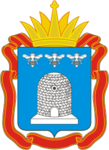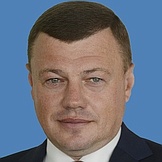Regional flags and emblems


PROFILE
Established 27 September 1937
Capital Tambov
Federal district: The Tambov Region is part of the Central Federal District
Area 34,500 sq km
Population 946 000 (2025)
Ethnic groups
(2020 National Census, %)
Russian – 95,61
Other – 4,39
Administrative divisions (2024)
Municipalities – 23
City districts – 7
Geography and climate
The region is located in the central part of European Russia, stretching about 250 km from north to south and over 200 km from east to west.
The region borders the Voronezh, Lipetsk, Ryazan, Penza, and Saratov regions.
There are about 1,400 rivers, 1,000 ponds and lakes, and eight large reservoirs. The major rivers are the Tsna, Vorona, and Lesnoy Voronezh.
The region has a moderate continental climate. The average January temperature is –7,1˚C. The average July temperature is 19,7˚C. The average amount of precipitation in January is 32 mm; in July – 64 mm. The duration of the vegetation season is 178 days in the north and 185 days in the south.
The region is home to the Voroninsky State Nature Reserve, 4 region-wide coverage state nature reserves and 5 natural landmarks.
Government
The legislative branch is represented by the Tambov Regional Duma, which is the permanent, representative and only body of legislative authority in the region.
The Tambov Regional Duma has 50 deputies elected for five years, with 25 of them running in single-mandate constituencies and the other 25 in the single electoral district, where winners are identified in proportion to the number of votes cast for lists of candidates nominated by electoral associations.
The current Regional Duma was elected in September 2021. Its term expires in September 2026.
The executive branch is the Head of the Tambov Region, the Government of the Tambov Region and other executive authorities of the region. The Government of the Tambov Region is the top permanent executive authority in the region.
The Head of the Tambov Region is the region’s highest-ranking official, who directs the executive power in the region, determines the system and structure of the executive bodies of the region. Head of the Tambov Region directly leads the Government of the region and has the rights of a member of the Government of the region.
The Head of the Tambov Region is elected for five years by Russian citizens who permanently reside in the region. The term of office of the Acting Governor – until the person elected Governor of the Tambov Region takes office.
Economy and natural resources
Industrial output accounts for over 16% of the regional GDP. Manufacturing industries are represented by plants specialising in the production of chemicals, machinery and equipment, electrical, electronic and optical equipment and vehicle production, as well as the food industry. The region occupies a leading position in the country in the production of alcohol, granulated sugar, vegetable oils, as well as in the manufacture of paints and varnishes, synthetic resins and plastics.
The region is home to a major cluster of defence companies, including TZ RevTrud, Efir Radio Engineering Research Institute, Tambovapparat plant, and Tambovsky Zavod Oktyabr.
The backbone of the region's economy is agriculture, which is a highly investment-intensive sector. Agriculture accounts for about 25% of the regional GDP. The region is the leading producer of grain, sugar beet, sunflower, soy, pork, alcohol, and sugar in the Central Federal District. Livestock accounts for over a third of the regional GDP. The region produces significantly more meat than it consumes. The major livestock producers are Tambovsky Bacon (Rusagro Group) LLC, Cherkizovo-Svinovodstvo LLC, RASK LLC, Tsentralnoye LLC, and Zolotaya Niva LLC. A horticultural cluster is rapidly developing in the region. The Michurin Federal Research Center for Horticulture and Healthy Nutrition, which is based in in the region, works on scientific and technological strategies to facilitate the development of Russia's agricultural industry through integration of intellectual resources and research infrastructure.
Culture and tourism
The region has significant tourism potential due to the availability of rich historical and cultural resources, the temperate continental climate, proximity to the capital and good transport accessibility.
The region has many places of interest associated with famous personalities: the composer Ivan Dzerzhinsky, poets Gavriil Derzhavin and Yevgeny Baratynsky, writers Alexei Novikov-Priboy and Sergei Sergeyev-Tsensky, the artist Alexander Gerasimov, the diplomat Georgy Chicherin, the scientist Vladimir Vernadsky, the inventor Alexander Lodygin, and others.
There are also many unique historical and cultural sites, such as the Noble Assembly House, the Naryshkin Reading Room, and the Aseyev House in Tambov, and the regional history museum, the art gallery, and the wolf museum.
Pilgrims are attracted to the numerous Orthodox shrines located in the region: the Transfiguration Cathedral in Tambov, the Bogolyubsky Cathedral and the Ilyinsky Cathedral in Michurinsk, the Ascension Convent, the Kazan Monastery, the Morshansk Trinity Cathedral, and others.
The region’s main health and wellness resorts are mineral waters and sapropelic muds. The mineral water Michurinskaya, from a source near Michurinsk, is rich in sodium chloride and bromine.


